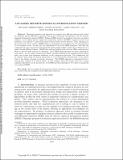| dc.contributor.author | Peherstorfer, Benjamin | |
| dc.contributor.author | Butnaru, Daniel | |
| dc.contributor.author | Willcox, Karen E. | |
| dc.contributor.author | Bungartz, Hans-Joachim | |
| dc.date.accessioned | 2014-07-10T13:31:03Z | |
| dc.date.available | 2014-07-10T13:31:03Z | |
| dc.date.issued | 2014-02 | |
| dc.date.submitted | 2013-11 | |
| dc.identifier.issn | 1064-8275 | |
| dc.identifier.issn | 1095-7197 | |
| dc.identifier.uri | http://hdl.handle.net/1721.1/88242 | |
| dc.description.abstract | This paper presents a new approach to construct more efficient reduced-order models for nonlinear partial differential equations with proper orthogonal decomposition and the discrete empirical interpolation method (DEIM). Whereas DEIM projects the nonlinear term onto one global subspace, our localized discrete empirical interpolation method (LDEIM) computes several local subspaces, each tailored to a particular region of characteristic system behavior. Then, depending on the current state of the system, LDEIM selects an appropriate local subspace for the approximation of the nonlinear term. In this way, the dimensions of the local DEIM subspaces, and thus the computational costs, remain low even though the system might exhibit a wide range of behaviors as it passes through different regimes. LDEIM uses machine learning methods in the offline computational phase to discover these regions via clustering. Local DEIM approximations are then computed for each cluster. In the online computational phase, machine-learning-based classification procedures select one of these local subspaces adaptively as the computation proceeds. The classification can be achieved using either the system parameters or a low-dimensional representation of the current state of the system obtained via feature extraction. The LDEIM approach is demonstrated for a reacting flow example of an H[subscript 2]-Air flame. In this example, where the system state has a strong nonlinear dependence on the parameters, the LDEIM provides speedups of two orders of magnitude over standard DEIM. | en_US |
| dc.description.sponsorship | United States. Air Force Office of Scientific Research (MURI program on Uncertainty Quantification under grant FA9550-09-0613) | en_US |
| dc.description.sponsorship | Massachusetts Institute of Technology (MIT-Germany Seed Fund) | en_US |
| dc.language.iso | en_US | |
| dc.publisher | Society for Industrial and Applied Mathematics | en_US |
| dc.relation.isversionof | http://dx.doi.org/10.1137/130924408 | en_US |
| dc.rights | Article is made available in accordance with the publisher's policy and may be subject to US copyright law. Please refer to the publisher's site for terms of use. | en_US |
| dc.source | Society for Industrial and Applied Mathematics | en_US |
| dc.title | Localized Discrete Empirical Interpolation Method | en_US |
| dc.type | Article | en_US |
| dc.identifier.citation | Peherstorfer, Benjamin, Daniel Butnaru, Karen Willcox, and Hans-Joachim Bungartz. “Localized Discrete Empirical Interpolation Method.” SIAM Journal on Scientific Computing 36, no. 1 (February 11, 2014): A168–A192. © 2014, Society for Industrial and Applied Mathematics. | en_US |
| dc.contributor.department | Massachusetts Institute of Technology. Department of Aeronautics and Astronautics | en_US |
| dc.contributor.mitauthor | Willcox, Karen E. | en_US |
| dc.relation.journal | SIAM Journal on Scientific Computing | en_US |
| dc.eprint.version | Final published version | en_US |
| dc.type.uri | http://purl.org/eprint/type/JournalArticle | en_US |
| eprint.status | http://purl.org/eprint/status/PeerReviewed | en_US |
| dspace.orderedauthors | Peherstorfer, Benjamin; Butnaru, Daniel; Willcox, Karen; Bungartz, Hans-Joachim | en_US |
| dc.identifier.orcid | https://orcid.org/0000-0003-2156-9338 | |
| mit.license | PUBLISHER_POLICY | en_US |
| mit.metadata.status | Complete | |
